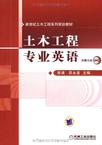土木工程专业英语
出版时间:2009-2 出版社:机械工业出版社 作者:陈瑛,邵永波 主编 页数:279
前言
本教材是专门为高等院校土木工程专业建筑工程方向学生学习专业英语而编写的,提供了集听、写、读于一体的综合训练模式,以全面提高土木工程专业学生专业英语的阅读、写作能力和听力水平。 本教材阅读和写作部分共分10章,共36篇,涵盖了结构力学、土木工程材料、结构设计基本概念、钢筋混凝土基本构件、钢结构、多层及高层建筑结构抗震设计、砌体结构、组合结构、地基与基础、建筑施工组织与管理10个方面的基本概念和原理。每一课包括文章阅读、生词与词组注解及科技写作指南。写作部分分类讲解了土木工程期刊论文标题、摘要、前言、方法、结果和讨论部分的写法;提供了描述图表、尺寸、材料性质、比较、定义、分类、范围的典型例句,供学生仿写;总结了学生进行土木工程论文写作常犯的语法错误;最后归纳了描述结构设计所常用的句子,供学生写毕业论文时参考。 本教材听力部分(附光盘)以结构抗震为主题,包含20篇短文,介绍了结构抗震的基本概念。每篇短文均模拟英语课堂,学生可以边看边听,在学到专业知识的同时提高专业英语听力水平,为参加国际间学术交流等奠定良好的基础。 本书的第2章到第9章及听力部分覆盖了大学本科建筑结构专业课的全部知识要点,以《建筑结构荷载规范》(GB 5009-2001)、《混凝土结构设计规范》(GB 50010-2002)、《建筑结构抗震设计规范》(GB 50011-2001)、《砌体结构设计规范》(GB 50003-2001)、《钢结构设计规范》(GB 50017-2003)和《建筑地基基础设计规范》(GB 50007-2002)为编写依据,力求讲解系统、概念清晰、条理明确。本书既可以作为建筑学工程管理专业学习建筑结构课程的双语教材,也可作为广大从事建筑工程专业、工程管理专业工程技术人员撰写英语论文的有益参考书。
内容概要
本教材是专门为高等学校土木工程专业建筑工程方向学生学习专业英语而编写的,本书通过集听、写、读于一体的综合训练模式,提高学生的专业英语水平。本书包括36篇文章的阅读、写作练习和随书光盘的20篇短文的听力练习共三大部分。内容涵盖了结构力学、土木工程材料、结构设计、钢筋混凝土基本结构、钢结构、多层及高层建筑结构抗震设计、砌体结构、组合结构、地基与基础、建筑施工组织与管理等方面英语文章阅读、词汇学习和科技论文写作指南。 本书适用于土木工程专业的本科生和研究生学习专业英语,也可作为土木工程领域的工程技术人员学习参考书。
书籍目录
PrefaceChapter 1 Structural Mechanics 1.1 Classification and Behavior of Structural Systems and Elements 1.2 Determinate and Indeterminate Structures 1.3 Structural Dynamics Chapter 2 Structural Material 2.1 Materials for Concrete and Mix Proportions 2.2 Properties of Concrete 2.3 Steel Materials 2.4 Structural Steel ShapesChapter 3 Structural Design Concepts 3.1 Load Conditions and Load Paths 3.2 Limit State DesignChapter 4 Concrete Structure 4.1 Flexural Behavior of Reinforced Concrete Bcam 4.2 Shear and Diagonal Tension in Reinforced Concrete Beam 4.3 Bond,Anchorage,and Development Length 4.4 Reinforced Concrete Column 4.5 Serviceability 4.6 Slab 4.7 Fundamentals of PrestressingChapter 5 Steel Structure 5.1 Steel Connections 5.2 Axially Loaded Steel Members 5.3 Steel BearnsChapter 6 Seismic Resistance of Structures 6.1 Earthquake-Induced Vibration of Structures 6.2 Structural Analysis Methods for Seismic Actions 6.3 Earthquake Resistant Structural Systems 6.4 Analysis of Rigid Reinforced Concrete Frame Structures 6.5 Ductile Design of Concrete Frame Structures Chapter 7 Masonry Structure 7.1 Masonry Properties 7.2 Masonry Construction System 7.3 Structural Performance of Confined Masonry Buildings 7.4 Masonry Structural DesignChapter 8 Composite Structure 8.1 Steel and Composite Structures 8.2 Concrete-filled Steel Tubular StructureChapter 9 Soil Mechanics and Foundation Engineering 9.1 Lateral Earth Pressure 9.2 FootingsChapter 10 Construction Management 10.1 The Procurement and Implementation of Structural Steel for Buildings 10.2 Instructions to Bidders References
章节摘录
2. Structural Stability A fundamental consideration in designing a structure is that of assuring its stability under any type of possible loading condition. All structures undergo some shape changes under load. In a stable structure the deformations induced by the load are typically small, and internal forces are generated in the structure by the action of the load tend to restore the structure to its original shape after the load has been removed. In an unstable structure, the deformations induced by a load are typically massive and often tend to continue increasing as long as the load is applied. An unstable structure does not generate internal forces that tend to restore the structure to its original configuration. Unstable structures quite often collapse completely and instantaneously as a load is applied to them. It is the fundamental responsibility of the structural designer to assure that a proposed structure does indeed form a stable configuration. Stability is a crucial issue in the design of structures that are assemblies of discrete elements. For example, the post-and-beam structure illustrated in Figure 1. 2a is apparently stable. Any horizontal force, however, tends to cause deformations of the type indicated in Figure 1.2b. Clearly, the structure has no capacity to resist horizontal load, nor does it have any mechanism that tends to restore it to its initial shape after the horizontal load is removed. The large changes in angle that occur between members characterize an unstable structure that is beginning to collapse. This particular structure will collapse almost instantaneously under load. Consequently, this particular pattern of members is referred to as a collapse mechanism.
图书封面
评论、评分、阅读与下载
用户评论 (总计17条)
- 学习本书之前应该好好的积累下专业英语单词词汇,很好的教材。
- 很新的书,附赠光盘,方便学习,很好的书
- 上课用的课本!挺实用的!老师很屌,英语说的很流利!!!!赞!
- 挺不错的 合法的一样
- 上课用的课本 不错啦
- It'sajustbookforStruc***alEnglish!
- 速度比上次快多了。
- 真的非常不错,我非常喜欢推荐
- 机械工程及自动化专业英语的听力部分是从网上下载的
- 这本教材一般般,原本以为是外语版的土木
- 看起来不错,挺适合结构方向的,虽然还没有看但是挺满意的
- 为了学习,买本看看,难度有一定,没有注释,得多花时间
- 感觉还行,要是有翻译就更好了,呵呵
- 这书没有中文,完全看不懂。。。
- 买来就放着了,总有一天能用到的说?
- 总体来说还是比较满意的,就是没有中文翻译。
- 非工科的看不懂~
推荐图书
- JavaScript开发技术大全
- 数码摄影与Photoshop影像处理
- 启东中学作业本 七年级英语(下)
- 上海往事
- 梦想跨越太平洋
- 改革开放30年中国高等教育改革亲历者口述纪实
- 2009机电产品报价手册(上下册)
- 围棋少年2(2009年)(低幼版)(适合4-8岁孩子阅读)
- 全球教育治理
- Stalingrad (平装)
- 当代北京婚恋史话
- 围棋少年(2009年1月刊)(幼儿版)(适合4-8岁孩子阅读)
- 概率论与数理统计同步训练
- 概率论与数理统计初步
- 陶养生命智慧
- 服装打板与推板技术
- 建造师12
- 虚幻与批判
- 包装结构设计教程
- 广播节目编辑与数字音频制作技术
- 农作制度新模式与技术
- 让孩子富裕一生(全四册)
- 老子讲读
- 国学丛考
- 科学哲学
相关图书
- 公司法操作小全书
- 民事诉讼法
- 刑事法判解(第10卷)
- 中国珍稀濒危海洋动物保护法律研究
- 合同法操作小全书
- 气经
- 阎崇年说清史
- The Economist(全年刊)
- Frommer’s Turkey, 5Th EditionFrommer土耳其导览,第5版
- Frommer’s Maui 2009Frommer毛伊岛导览2009
- 谁是你的情人
- 教育管理学的文化路向
- 学校教育行政管理的实践与思考
- 19世纪欧洲社会主义发展中的宗教问题研究
- 航空母舰和潜艇-军事.武器百科
- 战斗机和攻击机-军事.武器百科
- 坦克-军事.武器百科
- 军舰-军事.武器百科
- 手枪-军事.武器百科
- 最佳精细木工
- 中国农业劳动生产率的地区差异研究
- 新编会计信息化教程
- 初级会计专业技术资格考试大纲
- 管理会计
- Fortune(全年刊)
